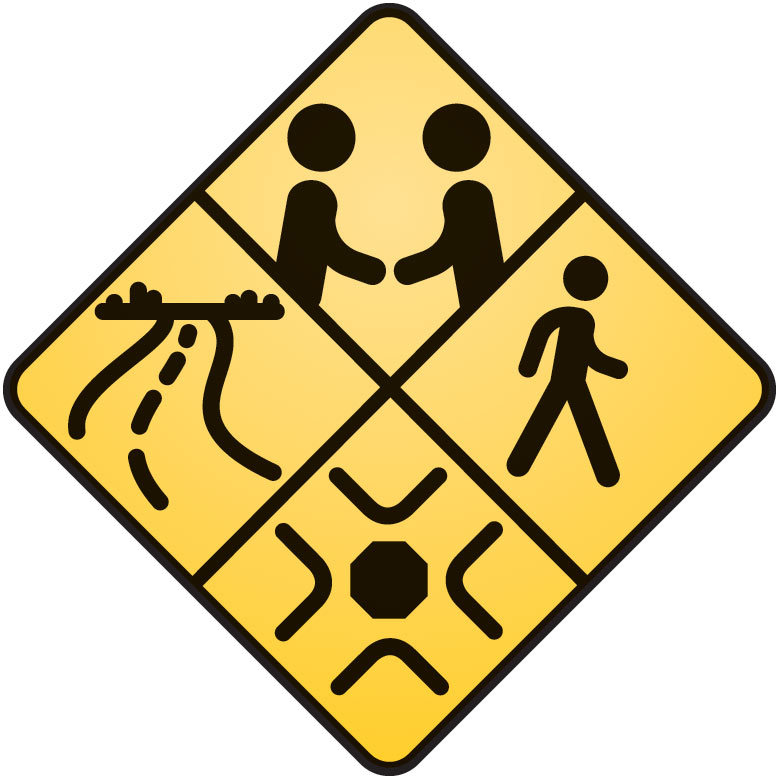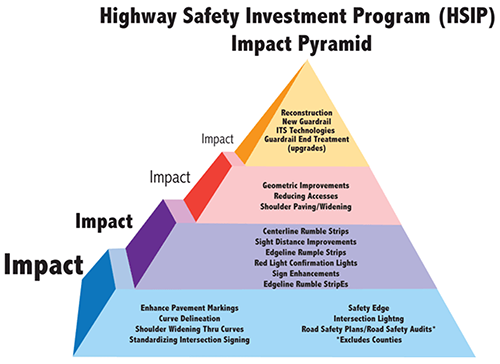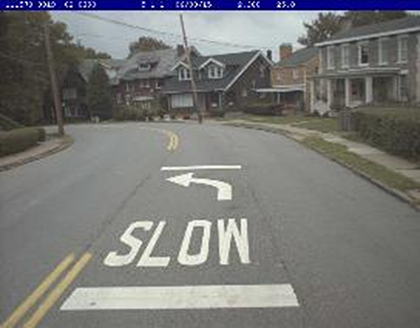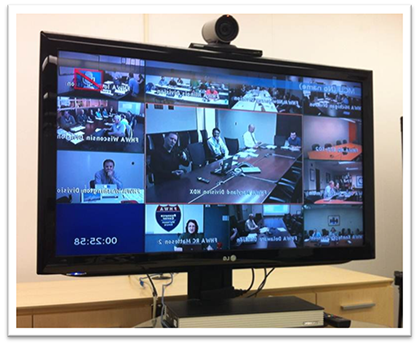U.S. Department of Transportation
Federal Highway Administration
1200 New Jersey Avenue, SE
Washington, DC 20590
202-366-4000
FHWA's RSPCB Peer-to-Peer Program (P2P) supports and sponsors peer exchanges and workshops hosted by agencies.
Date
May 14, 2013
Host
FHWA Office of Safety
Key Participants
Delaware Department of Transportation
FHWA Delaware Division Office
Illinois Department of Transportation
FHWA Illinois Division Office
Iowa Department of Transportation
FHWA Iowa Division Office
Kentucky Transportation Cabinet
Maryland Department of Transportation
FHWA Maryland Division Office
Michigan Department of Transportation
FHWA Michigan Division Office
Minnesota Department of Transportation
FHWA Minnesota Division Office
New Jersey Department of Transportation
FHWA New Jersey Division Office
Ohio Department of Transportation
FHWA Ohio Division Office
Wisconsin Department of Transportation
FHWA Wisconsin Division Office
FHWA Resource Center
U.S. DOT Volpe Center
FHWA's Office of Safety sponsors Peer to Peer (P2P) events.
Learn more

1. Introduction and Background
4. Key Areas of Interest and Next Steps
This report provides a summary of a peer-to-peer videoconference sponsored by the Federal Highway Administration (FHWA) Office of Safety. The videoconference was the third in a series of roadway departure-focused peer exchanges sponsored by the Office of Safety as a follow-up to face-to-face peer exchanges held with roadway departure Focus States in 2008 and 2009.
The Office of Safety invited nine States—Delaware, Illinois, Iowa, Maryland, Michigan, Minnesota, New Jersey, Ohio, and Wisconsin—to participate in this virtual peer exchange. The selected States were chosen based on the number and percentage of fatal crashes on horizontal curves, as well as geographic location. It was noted that of the States participating in this event, the percentage of crashes on curves is approximately the same as the national average. Nationally, 28 percent of fatal crashes are on curves. Also among the participant States, the ratio of crashes on the State roadway system versus the local roadway system is approximately 50/50.
The event allowed States to learn from peers who demonstrated innovative approaches to safety on horizontal curves, including high friction surface treatments (HFST) and pavement marking and signage programs. Peer presentations were made by the Kentucky Transportation Cabinet (KYTC), Michigan Department of Transportation (MDOT), Minnesota Department of Transportation (MnDOT), Wisconsin Department of Transportation (WisDOT), and Iowa Department of Transportation (Iowa DOT).
Eighty-one participants representing Departments of Transportation (DOTs), Local Technical Assistance Programs (LTAPs), and FHWA Division Offices attended the virtual peer exchange (see Appendix A for the complete list of event participants). The peer exchange discussions and presentations focused on the following topics (see Appendix B for the full agenda):
Facilitated roundtable discussions on each of the topics were a significant component of the event. During the discussions, each State shared its experiences in addressing safety on horizontal curves, including innovative practices and programs.
An FHWA Office of Safety representative welcomed participants to the peer exchange. Attendees then introduced themselves and briefly described what they were hoping to learn from the event.
Peers presented on a number of topics related to addressing safety on horizontal curves. The following section provides an overview of their presentations.
High Friction Surface Treatments
Tracy Allen Lovell, P.E., Kentucky Transportation Cabinet, Division of Traffic Operations
KYTC's Transportation Engineer presented on Kentucky's current crash and fatality statistics and discussed Kentucky's experience using HFST. Kentucky is a roadway departure Focus State with more than 60 percent of all highway fatalities being caused by roadway departure. In 2011, Kentucky had 670 fatal crashes resulting in a total of 721 fatalities and an economic cost estimated at over $2.1 billion. Kentucky has a Roadway Departure Implementation Plan with a number of countermeasures to reduce roadway departures. The plan includes:
Kentucky has nearly completed a pilot program installing HFST on horizontal curves with a high risk of roadway departure. To date, Kentucky has installed HFST at 79 sites, including over 100 curves, with an additional 17 sites due to be installed during the 2013 construction season. Kentucky initially began with a preliminary contract for two projects using the traditional design-bid-build method. Both projects were small and utilized a manual installation method. A subsequent systemic contract was developed covering 96 sites. The systemic contract is an “on call” contract which primarily utilizes a mechanical installation method. Kentucky is currently developing a future design-bid-build contract, as well as regional contracts (multiple sites per contract).
Kentucky presented the following project descriptions to demonstrate the success of the project:
KYTC has a six-year plan for reconstruction projects; projects are selected on curves that won't be re-built in the near future. Additional details on Kentucky's program include:
Michigan – Optical Speed Bars
Gary Loyola, Michigan Department of Transportation
MDOT's Traffic and Safety Engineer presented on Michigan's use of optical speed bars to reduce vehicle speeds. MDOT placed optical speed bars on the off-ramp of exit 12 on Interstate 94 in southwest Michigan. The ramp had experienced 13 roadway departure crashes in the past five years, mostly due to driver speeding. Half of these crashes occurred in dark conditions. The ramp's Average Daily Traffic (ADT) is 2,500 vehicles, including 30 percent trucks. The deceleration lane is unusually long, approximately one-quarter mile before entering a right-hand curve of a partial cloverleaf interchange.
The optical speed bars are 12 inches wide and 18 inches long and are placed perpendicular to the direction of travel outside of the vehicle wheel path. The spacing between the bars decreases as the curve approaches, creating an optical illusion to the driver that is intended to reduce their speed. The optical speed bars begin approximately 700 feet from the curve where the initial spacing between bars is 26 feet. This decreases to a spacing of 9 feet just prior to the point of curvature.
After installation of the optical speed bars, the average speed of drivers negotiating the ramp decreased only slightly, but the number of drivers negotiating the ramp at high speed (above 60 miles per hour) dropped significantly. In the three year period prior to installation, there were 13 crashes, 7 due to wet pavement and 5 at night. In the two and a half years after installation, the number of crashes was reduced to 6, 5 of which were at the ramp terminus (not on the curve) with only 1 wet surface roadway departure crash on the curve.
Minnesota – Implementing Curve Improvements
Brad Estochen and Julie Whitcher, Minnesota Department of Transportation
MnDOT's traffic safety engineers presented on Minnesota's experience in implementing horizontal curve improvements. Minnesota has 140,000 miles of roadway and in 2012 had 395 fatalities on its roadways and 1,042 severe injury crashes; 40 percent of the fatal crashes occurred on the State roadway system. Minnesota is pursuing diversity in its safety engineering program. It is implementing systemic deployment of safety improvements using a risk-based approach, but is also maintaining an ability to react to specific locations that experience multiple severe crashes. Minnesota distributes its $19.6 million in statewide Highway Safety Improvement Program (HSIP) funds based on each district's share of fatal and serious injuries.
The State has pursued a primarily systemic approach to safety funding distribution because, among other reasons, there are very few “black spots,” or individual curves with a disproportionate number of severe crashes. Of nearly 20,000 curves that the State evaluated, 95 percent had zero crashes in the past five years and an additional 2 percent had just one severe crash in the past five years. There were no curves that averaged one or more crashes per year. Though roadway departure crashes are over-represented in crashes on horizontal curves, not all curves are good candidates for safety improvements, and the presence of crashes is not a good indicator of relative risk. The systemic approach uses crash data plus geometric and traffic conditions to evaluate the entire system and identify target areas for safety investment.
MnDOT found that there was a higher crash density within certain ranges of each of the following four criteria used to evaluate the risk on curves:
As a result of the adoption of the systemic approach and risk rating criteria, counties and local agencies in Minnesota have been able to better identify projects for HSIP funding. The response to the 2014-2016 solicitation for HSIP funds was the largest ever: MnDOT received 137 applications for a total of $29.5 million, of which MnDOT funded $23 million in projects representing 45 counties.
Figure 1 explains MnDOT's approach to spending HSIP funds.

Iowa – Horizontal Curve Signing Program and Pavement Marking Experiment for Horizontal Curves
Jeremy Vortherms, Iowa Department of Transportation
Iowa DOT's State Transportation Safety Engineer made a presentation regarding Iowa's horizontal curve sign program. Iowa allocates a percentage of the State's gas tax to a safety fund and has used a portion of this funding for county signing projects. Once a year, counties can submit an application that includes a spreadsheet to assist with curve computations and cost and materials estimates. The goal of the program is to create a low paperwork environment and give counties flexibility in deciding which curves to treat. To date, approximately 20 counties have used the program, and some have applied multiple times. Iowa DOT uses workshops and other methods of outreach to inform counties of the program. The next step in the program is for Iowa DOT to provide maps and pre-screening tools to identify curves with the greatest need.
The State Transportation Safety Engineer also presented on Iowa's experimentation with pavement markings approaching horizontal curves. Iowa has piloted a pavement marking treatment at two sites similar to one used in Pennsylvania as shown in Figure 2. At both sites, it was inconclusive whether the markings had an effect on average speeds, but “higher end” speeding was reduced. One disadvantage is that the markings wear off, creating a maintenance issue. Iowa DOT is not currently considering the pavement markings as a treatment to deal with crash issues on horizontal curves.

Wisconsin – Automated Extraction of Curve Information
Rebecca Szymkowsk, Wisconsin Department of Transportation
WisDOT's State Traffic Engineer of Operations discussed the “Curve Finder” software (an ArcGIS add-in tool) that was developed at the Traffic Operations and Safety Lab at the University of Wisconsin. Within the State trunk roadway system, the Curve Finder uses photo logs and existing geographic information system (GIS) roadway maps to access curve information/data including length, radius, and degree of curvature. WisDOT has found this tool useful in identifying curves on the local road system. The software can be shared with other States.
Wisconsin Regional Safety Improvement Plans
Greg Helgeson, Wisconsin Department of Transportation
WisDOT's Northwest Region Traffic Safety Engineer discussed Wisconsin's Regional Safety Improvement Plans. The plans focus on low-cost systemic and sustainable treatments and have studied rural horizontal curves, evaluating risk factors including:
The plans have identified several treatments to address curves, including pavement markings, rumble strips, and chevrons. WisDOT has allocated three million dollars in maintenance funds for systemic improvements.
The participants addressed a number of key topics during the roundtable discussions; these topics are summarized in this section.
Q: How do States integrate locals into their safety program?
Q: Has your State developed local safety plans? Any success stories of using those plans to get projects funded and built?
Q: How are States addressing compliance for curves in the new Manual on Uniform Traffic Control Devices (MUTCD)? Are compliance updates being done systematically? Are States collecting speed data or using posted speed limits?
Q: What experimental measures are States pursuing and how do they feel about the risk in being experimental
Q: Do any States have a roadway departure plan or other systemic program developed by FHWA?
At the conclusion of the roundtable discussions, States discussed key areas of interest based on information that emerged from the peer exchange, as well as topics that they intend to explore in the future. Several States indicated that specifications are still needed for HFST. The moderator noted that several States do have specifications that can be shared, such as Kentucky, Maryland, and West Virginia. As a final roundtable, participants indicated what they plan to do differently based on what they learned during the peer exchange:
The greatest benefit of the virtual peer exchange was having multiple State agencies gathered and hearing about practices, reports, and coordination. This was an excellent opportunity for dialogue and information sharing.
- State DOT, Traffic Engineering Design Division Chief
The results of the evaluation distributed to participants after the event indicated that the virtual peer event was a success. Participants noted that the dual video conference/web conference made it more interactive compared to a webinar. They appreciated that each of the participating agencies could be seen on the screen in conjunction with the presentation slides on another screen. One participant said that the format was “much better than if the exchange had been audio all day.” Participants identified several other highlights from the event, such as:
Participants also provided suggestions on how the event could have been improved, such as:
Overall, the general consensus was that the focused approach presented at the peer exchange was much more worthwhile than a broad overview of these topics. One participant noted, “The greatest benefit was being able to interact with other State agencies that share the same problems without having to travel.” Another said that the roundtable discussion was beneficial in making sure everyone could offer their input. A State DOT division chief summed up a number of participants' thoughts: “The greatest benefit of the virtual peer exchange was having multiple State agencies gathered and hearing about practices, reports, and coordination. This was an excellent opportunity for dialogue and information sharing.” Figure 3 below shows a screen shot of the video interface, featuring ten States, the Resource Center, and Office of Safety participating in the event.

| FHWA/Volpe | |
|---|---|
| Dick Albin Safety Engineer Organization: FHWA Resource Center Business Phone Number: 303-550-8804 Business Email: dick.albin@dot.gov |
Frank Julian Safety Engineer Organization: FHWA Resource Center Business Phone Number: 404-562-3689 Business Email: frank.julian@dot.gov |
| Nicholas Artimovich Highway Engineer Organization: FHWA Office of Safety Business Phone Number: 202-366-1331 Business Email: nick.artimovich@dot.gov |
Jay Monty Planner Organization: US DOT/Volpe Business Phone Number: 617-494-3952 Business Email: joseph.monty.ctr@dot.gov |
| Joe Cheung Engineer Organization: FHWA Office of Safety Business Phone Number: 202-366-6994 Business Email: joseph.cheung@dot.gov |
Cathy Satterfield Safety Engineer Organization: FHWA Office of Safety Business Phone Number: 708-283-3552 Business Email: cathy.satterfield@dot.gov |
| Brian Fouch Team Leader, Safety Design Organization: FHWA Office of Safety Business Phone Number: 202-366-0744 Business Email: brian.fouch@dot.gov |
Susan Smichenko Community Planner Organization: US DOT/Volpe Business Phone Number: 617-494-3438 Business Email: susan.smichenko@dot.gov |
| Mike Griffith Office Director, Safety Technologies Organization: FHWA Office of Safety Business Phone Number: 202-366-9469 Business Email: mike.griffith@dot.gov |
|
| Delaware | |
| Patrick Kennedy Operations and Safety Engineer Organization: FHWA - Delaware Business Phone Number: 302-734-5326 Business Email: patrick.kennedy@dot.gov |
Adam Weiser Safety Programs Manager Organization: Delaware Department of Transportation Business Phone Number: 302-659-4073 Business Email: adam.weiser@state.de.us |
| Jim Pappas Assistant Director Organization: Delaware Department of Transportation Business Phone Number: 302-760-2379 Business Email: james.pappas@state.de.us |
|
| Illinois | |
| Anthony Baratta, P.E. Local Roads Field Engineer Organization: Illinois Department of Transportation - Region2/District 2 Business Phone Number: 815-284-5384 Business Email: anthony.baratta@illinois.gov |
Dan Long Systems Planning and Services Engineer Organization: Illinois Department of Transportation Business Phone Number: 815-284-5966 Business Email: dan.long@illinois.gov |
| Leonel Crespo Acting Geometrics Engineer Organization: Illinois Department of Transportation Business Phone Number: 309-671-3456 Business Email: leonel.crespo@illinois.gov |
Marshall Metcalf Traffic Operations Engineer Organization: Illinois Department of Transportation District 6 Business Phone Number: 217-785-5312 Business Email: marshall.metcalf@illinois.gov |
| Kim Cummins Local Roads Field Engineer Organization: Illinois Department of Transportation, District 6 Business Phone Number: 217-785-5342 Business Email: kim.cummins@illinois.gov |
Tim Sheehan Safety Design Unit Chief Organization: Illinois Department of Transportation Business Phone Number: 217-782-3568 Business Email: tim.sheehan@illinois.gov |
| Don Ernat D3 Local Roads and Streets Engineer Organization: Illinois Department of Transportation Business Phone Number: 815-434-8426 Business Email: donald.ernat@illinois.gov |
Peter Stresino Traffic Studies Engineer Organization: Illinois Department of Transportation Business Phone Number: 847-705-4135 Business Email: peter.stresino@illinois.gov |
| Lisa Heaven-Baum Traffic Programs Engineer Organization: Illinois Department of Transportation District 1 Business Phone Number: 847-705-4158 Business Email: lisa.heaven-baum@illinois.gov |
Priscilla Tobias State Safety Engineer Organization: Illinois Department of Transportation Business Phone Number: 217-782-3568 Business Email: priscilla.tobias@illinois.gov |
| Kahn Kellams CE III Organization: Illinois Department of Transportation Business Phone Number: 217-342-8247 Business Email: kahn.kellams@illinois.gov |
Kevin Trapp Operations Plans & Designs Engineer Organization: Illinois Department of Transportation - District 5 Business Phone Number: 217-466-7233 Business Email: kevin.trapp@illinois.gov |
| Randall Laninga Traffic Engineer Organization: Illinois Department of Transportation Business Phone Number: 309-671-4477 Business Email: randall.laninga@illinois.gov |
Riyad Wahab Safety Implementation Section Chief Organization: Illinois Department of Transportation Business Phone Number: 217-558-1793 Business Email: riyad.wahab@illinois.gov |
| Jonathan Lloyd Crash Analysis Engineer Organization: Illinois Department of Transportation Business Phone Number: 847-705-4137 Business Email: jonatho.lloyd@illinois.gov |
James Wessel Design and Planning Engineer Organization: Illinois Department of Transportation Business Phone Number: 618-346-3273 Business Email: james.wessel@illinois.gov |
| Greg Piland Safety Specialist Organization: FHWA Illinois Division Business Phone Number: 217-492-4645 Business Email: greg.piland@dot.gov |
|
| Iowa | |
| Nicole Fox Secondary Roads Engineer Organization: Iowa Department of Transportation Business Phone Number: 515-239-1506 Business Email: nicole.fox@dot.iowa.gov |
Jerry Roche Safety and Traffic Operations Engineer Organization: FHWA Iowa Division Office Business Phone Number: 515-233-7323 Business Email: jerry.roche@dot.gov |
| Jan Laaser-Webb Transportation Engineer Specialist Organization: Iowa Department of Transportation Business Phone Number: 515-239-1349 Business Email: jan.laaser-webb@dot.iowa.gov |
Steven Schroder Transportation Engineer Organization: Iowa Department of Transportation Business Phone Number: 515-239-1623 Business Email: steven.schroder@dot.iowa.gov |
| Terry Ostendorf Program Planner Organization: Iowa Department of Transportation Business Phone Number: 515-239-1077 Business Email: terry.ostendorf@dot.iowa.gov |
Jeremey Vortherms State Transportation Safety Engineer Organization: Iowa Department of Transportation Business Phone Number: 515-239-1267 Business Email: jeremey.vortherms@dot.iowa.gov |
| Kentucky | |
| Tracy Lovell Transportation Engineer Organization: Kentucky Transportation Cabinet Business Phone Number: 502-564-3020 Business Email: tracy.lovell@ky.gov |
|
| Maryland | |
| Paulo DeSousa Assistant Chief, Pavement and Geotechnical Division Organization: Maryland State Highway Administration Business Phone Number: 443-572-5061 Business Email: pdesousa@sha.state.md.us |
Dilip Patel Assistant Division Chief Organization: Maryland State Highway Administration Business Phone Number: 410-787-5811 Business Email: dpatel@sha.state.md.us |
| Breck Jeffers Operations and Safety Engineer Organization: FHWA - Maryland Division Office Business Phone Number: 410-779-7153 Business Email: breck.jeffers@dot.gov |
Michael Paylor Division Chief Organization: Maryland State Highway Administration Business Phone Number: 410-787-4027 Business Email: mpaylor@sha.state.md.us |
| Michigan | |
| Mark Bott Engineer of Traffic & Safety Organization: Michigan Department of Transportation Business Phone Number: 517-335-2625 Business Email: bottm@michigan.gov |
David Morena Highway Safety Specialist Organization: FHWA Michigan Division Business Phone Number: 517-702-1836 Business Email: david.morena@dot.gov |
| Mary Bramble Transportation Engineer Organization: Michigan Department of Transportation Business Phone Number: 517-335-2837 Business Email: bramblem1@michigan.gov |
Jill Morena Pavement Marking Specialist Organization: Michigan Department of Transportation Business Phone Number: 517-373-3340 Business Email: morenaj@michigan.gov |
| Tracie Leix Safety Programs Unit Supervisor Organization: Michigan Department of Transportation Business Phone Number: 517-373-8950 Business Email: leixt@michigan.gov |
Sarah Woolcock Coloma TSC Operations Engineer Organization: Michigan Department of Transportation Business Phone Number: 269-217-7805 Business Email: woolcocks@michigan.gov |
| Gary Loyola Coloma TSC Traffic Safety Operations Engineer Organization: Michigan Department of Transportation Business Phone Number: 269-849-2346 Business Email: loyolag@michigan.gov |
|
| Minnesota | |
| Brad Estochen State Traffic Safety Engineer Organization: Minnesota Department of Transportation Business Phone Number: 651-234-7011 Business Email: bradley.estochen@state.mn.us |
Will Stein Safety Engineer Organization: FHWA - Minnesota Division Office Business Phone Number: 651-291-6122 Business Email: william.stein@dot.gov |
| Sulmaan Khan Assistant Project Development Engineer Organization: Minnesota Department of Transportation Business Phone Number: 651-366-3829 Business Email: sulmaan.khan@state.mn.us |
Julie Whitcher Assistant State Traffic Safety Engineer Organization: Minnesota Department of Transportation Business Phone Number: 651-234-7019 Business Email: julie.whitcher@state.mn.us |
| Derek Leuer Traffic Safety Engineer Organization: Minnesota Department of Transportation Business Phone Number: 651-234-7372 Business Email: derek.leuer@state.mn.us |
Almin Ramic Grad 2 Engineer Organization: Minnesota Department of Transportation Business Phone Number: 651-366-4696 Business Email: almin.ramic@state.mn.us |
| New Jersey | |
| Chris Barretts Manager Organization: New Jersey Department of Transportation Business Phone Number: 609-530-2600 Business Email: chris.barretts@dot.state.nj.us |
Janet Leli Director Organization: NJ LTAP Business Phone Number: 848-445-2906 Business Email: jleli@rci.rutgers.edu |
| Evan Bossett Organization: CAIT/TSRC Business Phone Number: 732-445-2882 Business Email: bossett@rutgers.edu |
Jennifer Marandino Team Leader - Capital Programming & Safety Organization: South Jersey Transportation Planning Organization Business Phone Number: 856-794-1941 Business Email: jmarandino@sjtpo.org |
| Yosy Cosme Assistant Engineer Organization: New Jersey Department of Transportation Business Phone Number: 609-530-8737 Business Email: yosy.cosme@dot.state.nj.us |
Angela Quevedo Senior Engineer Organization: New Jersey Department of Transportation Business Phone Number: 609-530-4677 Business Email: angela.quevedo@dot.state.nj.us |
| George Fallat Traffic Engineer Organization: Mercer County Business Phone Number: 609-989-6642 Business Email: gfallat@mercercounty.org |
Virgilio Tan Senior Engineer Traffic Organization: New Jersey Department of Transportation Business Phone Number: 609-530-5696 Business Email: virgilio.tan@dot.state.nj.us |
| Andy Kaplan Senior Transportation Safety Engineer Organization: Rutgers Transportation Safety Resource Center Business Phone Number: 609-213-6252 Business Email: agrkaplan@gmail.com |
Andrew Tracy Assistant Planner Organization: South Jersey Transportation Planning Organization Business Phone Number: 856-794-1941 Business Email: atracy@sjtpo.org |
| Matthew Lawson Principal Planner Organization: County of Mercer, NJ Business Phone Number: 609-989-6551 Business Email: mlawson@mercercounty.org |
Caroline Trueman Safety Engineer Organization: FHWA NJ Business Phone Number: 609-637-4234 Business Email: caroline.trueman@dot.gov |
| Ohio | |
| Michael B. Armstrong Safety Engineer Organization: FHWA, Ohio Division Business Phone Number: 614-280-6855 Business Email: michael.armstrong@dot.gov |
Victoria Beale LTAP Center Director Organization: Ohio LTAP Center/Ohio Department of Transportation Business Phone Number: 614-466-3129 Business Email: victoria.beale@dot.state.oh.us |
| Michael McNeill Transportation Engineer Organization: Ohio Department of Transportation Business Phone Number: 614-387-1265 Business Email: michael.mcneill@dot.state.oh.us |
|
| Wisconsin | |
| Andrea Bill Associate Researcher Organization: Traffic Operations and Safety Laboratory University of Wisconsin-Madison Business Phone Number: 608-890-3425 Business Email: bill@wisc.edu |
David Jolicoeur Safety Engineer Organization: FHWA - Wisconsin Division Office Business Phone Number: 608-829-7520 Business Email: david.jolicoeur@dot.gov |
| Allison Blackwood Traffic Operations Engineer Organization: Wisconsin Department of Transportation Business Phone Number: 262-521-5367 Business Email: allison.blackwood@dot.wi.gov |
Tony Kemnitz Traffic Safety Engineer Organization: Wisconsin Department of Transportation Business Phone Number: 715-421-8023 Business Email: tony.kemnitz@dot.wi.gov |
| John Bridwell Standards Development Engineer Organization: Wisconsin Department of Transportation Business Phone Number: 608-266-8664 Business Email: john.bridwell@dot.wi.gov |
Karen Martens Traffic Engineer Organization: Wisconsin Department of Transportation Business Phone Number: 262-548-6892 Business Email: karen.martens@dot.wi.gov |
| Dan Dedrick Safety Engineer Organization: Wisconsin Department of Transportation - SE Region Business Phone Number: 262-548-5894 Business Email: dan.dedrick@dot.wi.gov |
Eric Perea Traffic Operations Engineer Organization: Wisconsin Department of Transportation Business Phone Number: 262-574-5422 Business Email: eric.perea@dot.wi.gov |
| Erik Emerson Standards Development Engineer Organization: Wisconsin Department of Transportation Business Phone Number: 608-266-2842 Business Email: erik.emerson@wi.gov |
Stacey Pierce Traffic Engineer Organization: Wisconsin Department of Transportation Business Phone Number: 262-548-5958 Business Email: stacey.pierce@dot.wi.gov |
| Joshua Falk Civil Engineer - Signing & Pavement Marking Organization: Wisconsin Department of Transportation Business Phone Number: 920-492-7165 Business Email: joshua.falk@dot.wi.gov |
Rebecca Szymkowski State Traffic Engineer of Operations Organization: Wisconsin Department of Transportation Business Phone Number: 608-266-9381 Business Email: rebecca.szymkowski@dot.wi.gov |
| Greg Helgeson Traffic Safety Engineer Organization: Wisconsin Department of Transportation, NW Region Business Phone Number: 715-836-2980 Business Email: greg.helgeson@dot.wi.gov |
Amy Taetsch CE-Trans Organization: Wisconsin Department of Transportation Business Phone Number: 262-548-8641 Business Email: amy.taetsch@dot.wi.gov |
| 9:30 - 11:30 | Morning Session |
|---|---|
| Welcome, Overview and Introductions
Presentation and Q&A
Roundtable Discussions on Pavement Treatments for Curves
Roundtable Discussions on Delineation and Warning Practices for Curves
|
|
| 11:30 - 12:15 | Lunch |
| 12:15 - 2:00 | Afternoon Session |
Roundtable Wrap-Up on Delineation/Warning
Presentation
Roundtable Discussion on Implementing Curve Programs
Take-Away Items
|
|
| 3:00 | Close |
